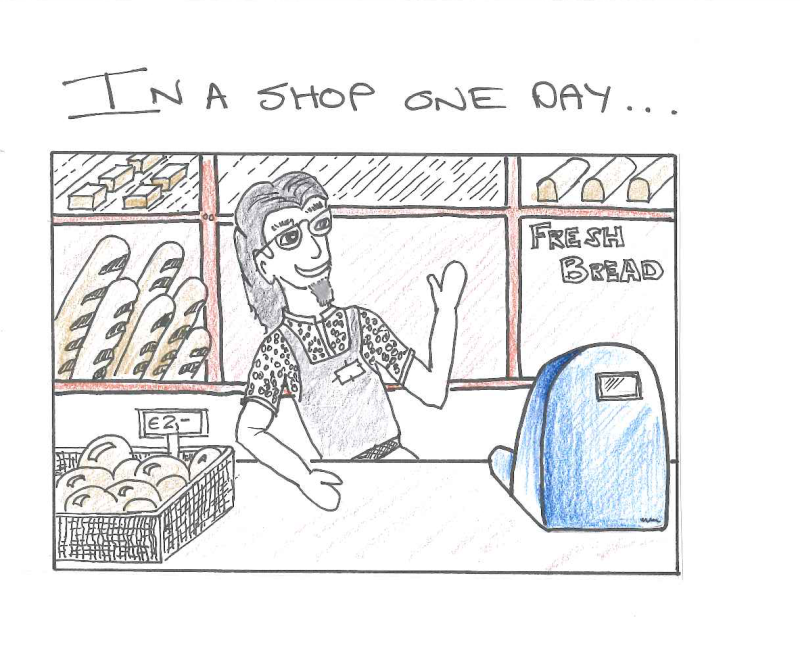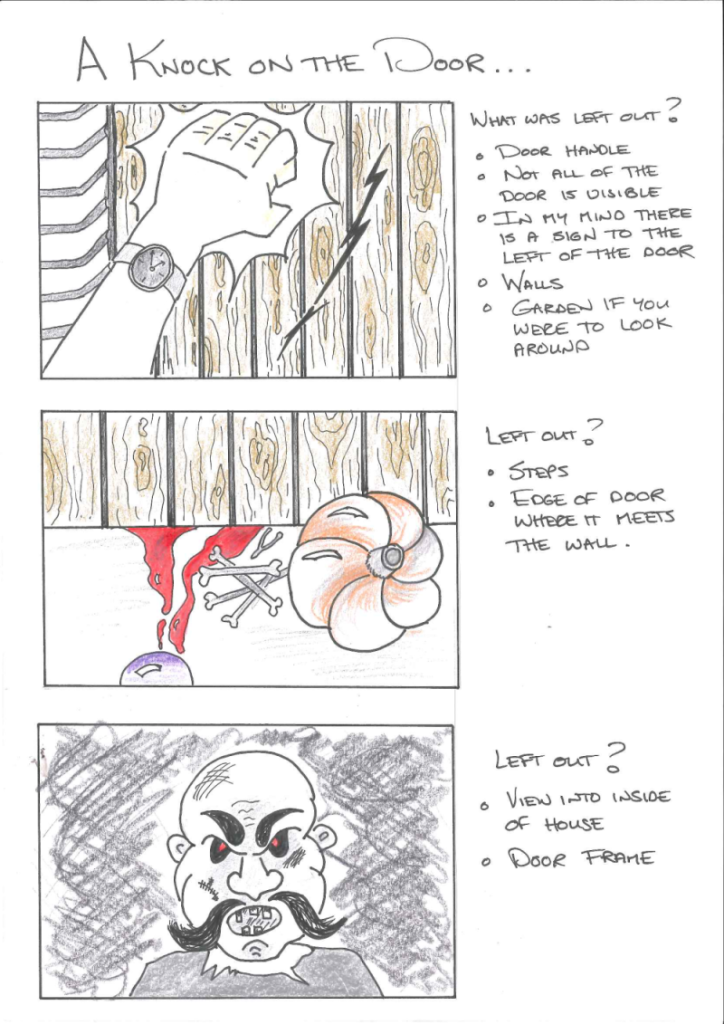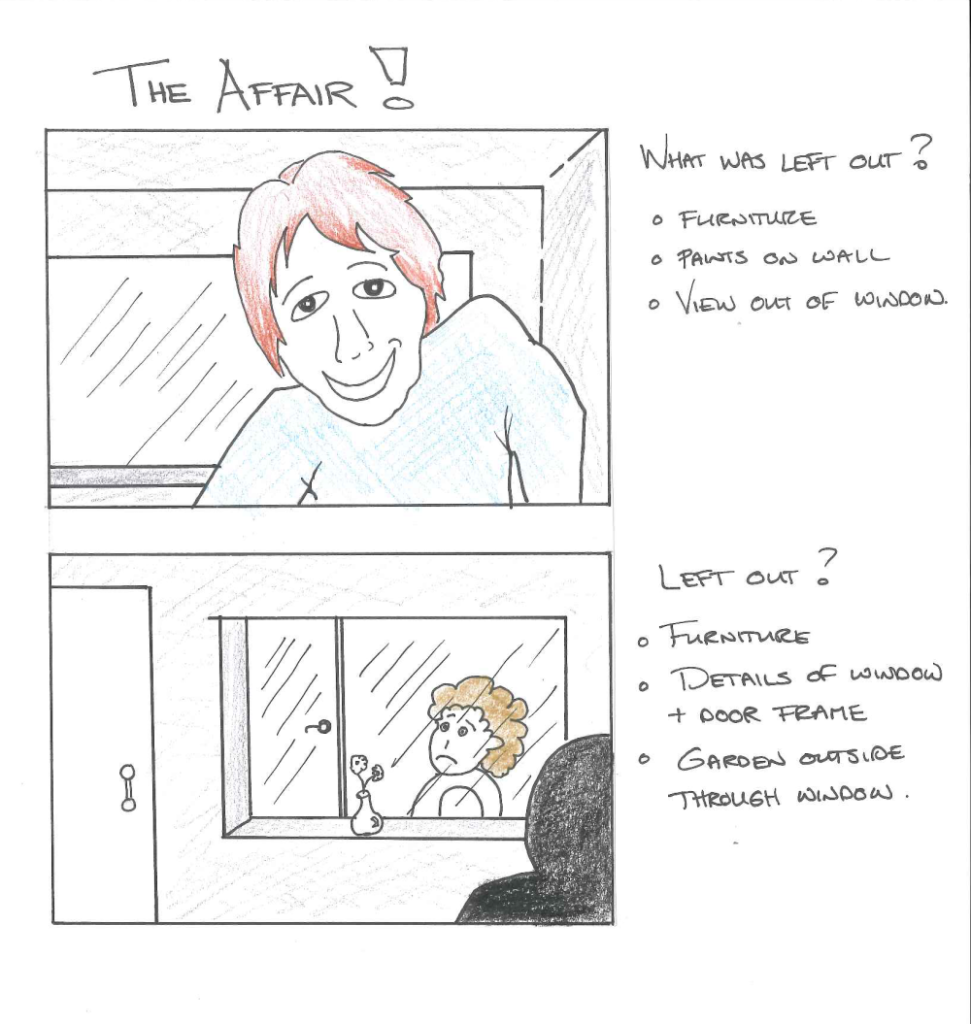For this exercise you are asked to visualize a set of situations and then draw up the storyboard of what you would see and answer a series of questions. This is a subjective view exercise.
Talking to someone in a shop
What was left out at the edges?
- The refrigerated stand with cakes in it
- Additional racks of bread and pastries
- The bottom of the counter with signs on it
Note the things you were aware of but chose not to ‘see’
- The mess behind the counter (dustbins, a chair, empty boxes)
- Overhead lights
- The marks on the counter
Why did you leave them out?
- They were unnecessary details that would have cluttered up the picture
- What was put in was enough for the viewer to know that it is a bakery and that the guy is speaking in an animated way – that was enough to convey the message
Will the viewer be aware that they are there?
- For the lighting, at a certain level, yes if it were filmed, but from the storyboard it is hard to tell what time of day it is, so the lighting may or may not be there
- The mess behind the counter – no, the viewer would not be aware, unless their experience if bakeries is of messy storage, in which case they may sense this mess
- Marks on the counter – same as above, the viewer may ‘imagine’ a scuffed or marked counter if this is what they experience with bakeries, otherwise not.
A Knock on the Door …

What was left out at the edges?
- I’ve marked these up next to each frame.
Note the things you were aware of but chose not to ‘see’
- Details – cobwebs in wooden panel cracks
- Messy environment outside the door
- Interior of house when door was opened
Why did you leave them out?
- I wanted the scene to be overtly scary so even though I imagined a messy, run-down environment, I didn’t want it to distract from the ‘red’ stuff seeping out from under the door (personally this would be the last visual of the door for me as I would not wait for it to be opened, my next subjective visual would be the path as dashed down it on my way out.) Too much detail would have detracted from what I would have been focused on.
- The same is true for the last frame – I could not imagine being even vaguely aware of the door frame and interior of the house if I were confronted with an angry, weird looking guy (having just realized what the red stuff was under the door!). I would be completely focused on the guys face.
Will the viewer be aware that they are there?
- For the first frame, the viewer may get a sense of the disrepair of the door and imagine its surroundings to be similar.
- For the last two frames, probably not since they would (hopefully) be focused on the same things as me
The Illicit Affair!

What was left out at the edges?
- I’ve marked these up next to each frame
Note the things you were aware of but chose not to ‘see’
- View out of the window of the environment which I imagined to be a garden
- Expression on the face of the lover when I look out the window (frame 2)
Why did you leave them out?
- The garden was an unnecessary detail hat didn’t add anything to the story
- I would be panicking if I saw the wife of my lover approaching the front door and clearly aware of what is going on inside. The reaction of the lover would hardly matter at this immediate point in time. Later, it would be interesting but only after I have got over the initial shock of what I am seeing out the window.
Will the viewer be aware that they are there?
For the scenery out the window – in a very limited way the viewer will be conscious that there is something outside the window (garden, block of flats etc.) but this will not be their main focus
For the lovers reaction – this depends on how quickly the viewer recovers from the ‘shock’ – having understood who is about to walk into the house, the viewer may then move their attention to the lover. If there were another shot, it would be me looking at the lover to see if they have noticed and their reaction.
______________________
A bit of reflection: I think the main value of this exercise is two-fold. Firstly, to consider how you would frame a subjective shot. The second is to consider, once you have decided on the shot, what within that shot is important and what is extraneous. If there is too much unnecessary detail in the shot, it could detract from what you want the viewer to look at.
I do think that filming with a subjective shot can be very difficult because it relies so completely on one POV and one visual reference. If the shot were genuinely from the ‘eyes’ of the character, you would most likely also need to know what they were thinking if the message were subtle. If the message were more dramatic or extreme, this probably wouldn’t be necessary e.g. someone has jumped out in front of the character and scared them – you don’t need to know what they thinking because you got a fright as well.

This was brilliant, I love your drawing style it’s so good and I love to see how you create each scene. Like the way you chose the dramatic story for the opening the door, like you I would have been fleeing down the path as well. The affair was great as well, with your lover in silhouette and the focus on the upset wife in the window. I like how he was in silhouette, gives a new meaning to a ‘shady affair’ 🙂